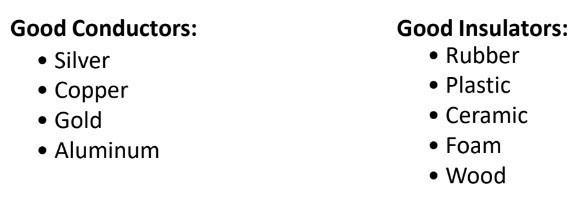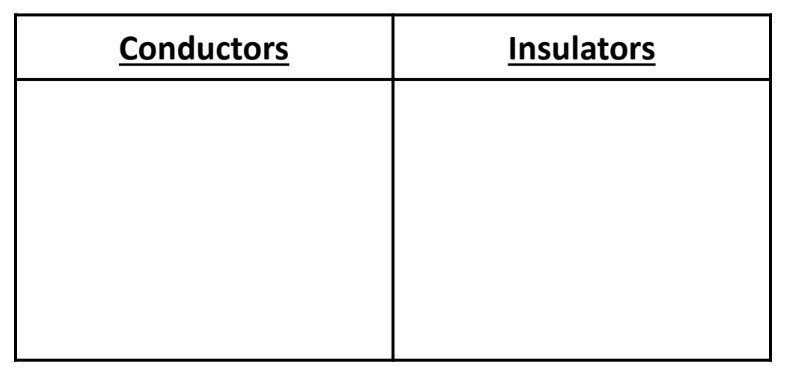
Overview
Title: Testing for Conductivity with Different Conductors and Insulators
Grade: 5th Grade
Duration: 30 Minutes
Standards
Science – SC.5.P.10.3
Investigate and explain that an electrically charged object can attract an uncharged object and can either attract or repel another charged object without any contact between objects.
Science – SC.5.P.11.2
Identify and clarify materials that conduct electricity and materials that do not.
Language Arts – LAFS.5.SL.1.1
Engage effectively in a range of collaborative discussions (one-on-one, in groups, and teacher-led) with diverse partners on grade 5 topics and texts,building on others’ ideas and expressing their own clearly.
Essential Questions
- What causes an electric charge to occur?
- What is the relationship between and insulator and a conductor?
Vocabulary
Static Electricity • Force • Electric Force • Repel • Attract • Electric Discharge • Magnet • Insulator • Conductor
Background Information
Electric charge occurs when a buildup of electricity transfers from one object to another. The electric force will either attract or repel depending on the charge. There are good and bad conductors of heat and electricity.

Guiding Questions
- How does electricity work?
- What materials are good conductors of electricity?
- What parts are needs in order to make an electrical circuit?
- What is an electrical current and how do they work?
- How can electrical currents be used in order to make a magnet?
- What can electricity flow through?
- What are the effects of moving charges?
- What causes an atom to have a negative or positive charge?
- What are the effects of moving charges?
- What causes an atom to have a negative or positive charge What effect might be caused by electrons being loosely bound to atoms in a material?
- Is it possible to categorize all conductors as metals? Why or why not?
- What is the difference between an insulator and a conductor?
- If an insulator is placed into a series circuit containing a battery and a light bulb,will the light bulb be able to light? Why or why not?
- If a conductor is placed into a series circuit containing a battery and a light bulb,will the light bulb be able to light? Why or why not?
- What is static electricity?
- Have you ever dragged their feet across the room? What happened when they touched something after ward?
- Have you ever received a shock when they’ve touched something? Have you ever shocked someone?
Inquiry Lab
- Guided Inquiry/Small Groups – Inquiry Lab
Teacher Resources
Testing for Conductivity with Different Conductors and Insulators Simulation Lab
Testing for Conductivity with Different Conductors and Insulators Simulation Lab
After learning about conductors and insulators of electricity, students will take complete simulation lab that will let them see which items are the best conductors of electricity. This activity can be done as a whole group activity projected from the computer onto the Whiteboard or can be done in small group or individually.
Materials
- Computer(s)
- Whiteboard (Optional)
- Website: Conductors and Insulators
- Website: Testing for Conductivity with Different Conductors and Insulators Simulation Lab
Procedure
- Have students brainstorm what items they think are good conductors and insulators of electricity. You may create a two-column note chart on the board and have students create their own on a blank paper to write down their ideas (see example below)

- Next, visit Website: Conductors and Insulators. Before reading, assess prior knowledge by having students take the electricity quiz.
- Have students read about conductors and insulators. Compare the items that they came up with during the brainstorming session to the ones mentioned in the DK find out article.
- Students will then work in pairs or individually on their own computer/tablets on Website: Testing for Conductivity with Different Conductors and Insulators Simulation Lab
- Test various conductors and insulators found in the simulation. (This can also be done whole group on Whiteboard.)
- When you visit the website, you will see that there is a simple circuit is set up.
- You will place each of the items (alloy metal, water, salt water, copper, glass, wood,graphite, aluminum, plastic) from the boxes above into the alligator clips in the circuit to close the circuit and see what happens.
- Did the light bulb light up?
- Is the item an insulators or a conductor?
- What other items could they have included?
- Discuss the results.
- Discuss what other items could have been tested?
- What are the advantages/disadvantages of completing a simulation lab?
